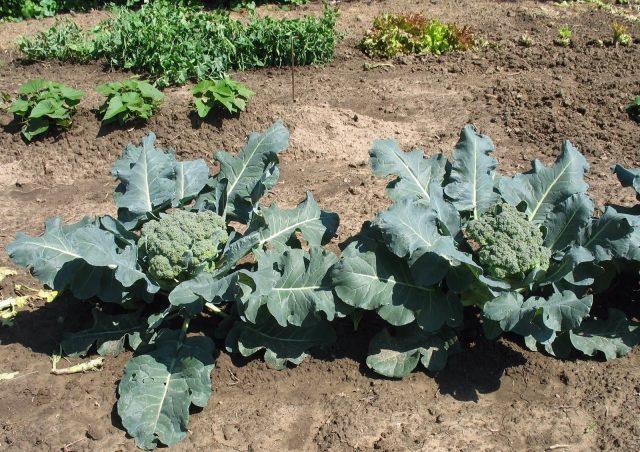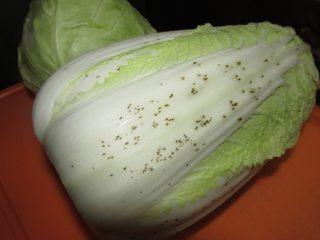Content
It is worth planting cabbage seedlings in the Moscow region from the first ten days of March to the second ten days of April. The timing of sowing seeds for seedlings depends on the type and variety of cabbage. Early ripening varieties are planted earlier, late varieties - at the last stage. In addition, it is important to know how many days should pass from sowing to transplanting into the ground. Typically this period ranges from 25 to 50 days.
When to sow cabbage for seedlings in the Moscow region
When planning sowing seeds for seedlings in the Moscow region, the variety of cabbage and the time of ripening of the seedlings are taken into account. Recommendations for planting dates for the main varieties are described in the following sections.
White and colored
White cabbage and colored varieties are planted from March 1 to April 20. The timing depends on the variety category:
- early ripening varieties are placed for seedlings from March 1 to March 28;
- mid-season - March 28 to April 20;
- sowing of seedlings of late varieties should be planned for the period from April 1 to April 20.
You can plan a landing on almost any day, with the exception of full moons.In 2023 they fall on March 7, April 6 and May 5.
Kohlrabi
In the Moscow region and other regions of the middle zone, you can sow kohlrabi cabbage seedlings at approximately the same time as white cabbage. Early varieties are sown from the first days to the last ten days of March. Mid-season varieties can be sown from March 20 to April 20, and late varieties can be sown in the first or second ten days of April.
Broccoli
Broccoli is less demanding than other varieties of cabbage, including white cabbage. This is the most undemanding crop, so planting seedlings in the Moscow region can be planned for almost any day. The main period is from March 15 to April 20.
You can be guided by the fact that at least 35 days must pass from the emergence of seedlings to transplantation into the ground. Moreover, the seeds hatch in 7-10 days.
But even if the main deadline has been missed, you can sow kohlrabi cabbage in the Moscow region directly into the ground (without growing seedlings). The work is planned for the last days of April or during the May holidays. At the first stage, the seeds are covered with film and periodically removed for ventilation. You can grow kohlrabi even in open ground without fear - the crop can withstand short-term frosts down to -7 degrees.

In the Moscow region, broccoli can be immediately planted in open ground
Brussels
The timing of sowing Brussels sprouts for seedlings in the middle zone approximately coincides with white cabbage. The crop does not react well to heat, so it is transferred to open ground in the first half of May. The ripening period of seedlings from the moment of germination to transfer to the beds is about 40-50 days.
Accordingly, seeds should be sown from the third decade of March to mid-April.Early varieties are sown at the end of March, middle varieties - from April 1 to 10, and late varieties - from April 5 to 15.
Beijing
Sowing Chinese cabbage seeds for seedlings in the Moscow region can be planned two times:
- first wave – from March 20 to 30;
- the second period is from June 20 to 30.
The crop ripens quite quickly - the seedlings are ready for transplantation after 25-30 days. Therefore, planting can begin within the designated time frame. If time is lost, the seeds can be sown directly into the ground at the end of April or during the May holidays.
Savoy
The timing of planting Savoy cabbage seedlings in the Moscow region also depends on the variety category:
- early ripening varieties are sown in the second ten days of March;
- middle and late varieties - exactly a month later (second ten days of April).
Seedlings ripen on average in 40-50 days. You also need to plan time for the emergence of seedlings (7-10 days). They are transferred to open ground for the May holidays. Therefore, planting seedlings in the Moscow region is planned for the period from mid-March to the 20th of April.
Landing rules
Cabbage is unpretentious, but requires compliance with a certain temperature regime. When sowing seeds for seedlings, it should be noted that they grow well only in cool conditions. Therefore, the boxes are placed on a balcony, loggia, or the seeds are immediately sown in open ground. The basic growing rules are described in detail below.
Soil preparation
First of all, you need to start preparing the soil. A universal mixture purchased in a store is suitable for growing. But you can also compose it yourself. For this, different proportions are used:
- Garden soil with black peat and humus 1:1:1.
- Garden soil with rotted sawdust and black peat 1:1:3.
- Turf soil with black peat, sand and humus 2:1:1:1.
- Humus with black peat 1:3.

The soil for seedlings should be fertile and loose
Before sowing cabbage in the Moscow region, the soil must be disinfected. To do this, pour it with a solution of potassium permanganate 1-2 g per 1 liter or put it in the freezer for several days. Instead, you can keep it in the oven for 15 minutes at 120 degrees. Then it is recommended to apply bacterial fertilizing, for example. "Rizotorfin".
Selection of capacity
For cultivation, you can take any containers of small depth (10-12 cm) and sufficient width to accommodate as many seedlings as possible. Typically, gardeners use wooden or plastic containers. After picking, you can use peat pots or plastic cups.
If grown without replanting, seedlings in the Moscow region can be planted immediately in peat tablets. It is recommended to first douse the containers with boiling water or a bright pink solution of potassium permanganate.
Seed preparation
Before sowing seedlings, cabbage seeds should be prepared. First, they are poured onto a flat surface and damaged, small and dried ones are discarded. Then put it in a saline solution (a heaping tablespoon per liter of water). If any grains end up on the surface, they are also thrown away.
The next stage of preparation for sowing seedlings in the Moscow region is disinfection. The seeds are pickled in a solution of potassium permanganate 3 g per 1 liter and kept for no more than 5 minutes. Then rinse under the tap and place on a flat surface to dry completely.
The last stage is soaking. You should proceed like this:
- Place gauze on a flat saucer.
- Distribute the grains evenly on it.
- Pour water with a few drops of “Kornevin” or another growth stimulant.
- After four hours, change the water.
- Let it stand for another 3-4 hours, then start sowing.
Sowing scheme
When planting seedlings in the Moscow region, it is necessary to carefully observe the interval so that the seedlings are not too dense. To do this, use the traditional scheme:
- furrow depth – 1 cm;
- distance between rows – 3-4 cm;
- the gap between seeds is 2 cm.

Leave an interval of 2-3 cm between sowings
Cabbage is not always grown with pickling. Seeds in a common container can be planted in a checkerboard pattern with an interval of 5-10 cm. Then replanting will not be necessary, which will greatly simplify the process.
If you immediately plant them in separate cups, it is better to distribute two grains into each of them to a depth of 1 cm. After germination, weak seedlings are pinched, leaving only strong ones.
Regardless of the chosen method, sowing seeds for seedlings is carried out as follows. First, thoroughly moisten the soil with a spray bottle, then mark shallow furrows or individual holes. Place the grains and sprinkle a little soil.
Seedling care
Caring for cabbage seedlings in the Moscow region is not so difficult. The main requirement is to create a suitable temperature regime and maintain constant humidity. There are other rules of care - they are described in detail below.
Temperature
To grow cabbage seedlings in the Moscow region, it is very important to maintain the temperature regime:
- Until the emergence of seedlings, the temperature should be at room temperature, but not higher than +22 °C.
- After germination of the seedlings, it is reduced to 8-10 degrees. You can move the boxes to a loggia or closed balcony.
- After two weeks, the temperature is raised to +15°C.
- 15 days before transplanting into open ground, seedlings begin to harden.
Watering and fertilizing
When growing cabbage seedlings in the Moscow region, you need to water them regularly.First, the seedlings are moistened three times a week with a spray bottle. The water must be pre-settled. After the temperature is reduced to 10-15 degrees, water can be given twice a week. It is important to ensure that the soil does not dry out, but at the same time is not too wet.
If you grow cabbage seedlings in the Moscow region, you should also take care of feeding. At the first stage, it is not necessary to add (if there is peat or humus in the soil). A few days after picking, the plants are given a complex fertilizer, for example, “Baikal” or “Kemira”. Another fertilizing can be done literally three days before transplanting into open ground.
Picking
It is best to plant cabbage in peat pots. In this case, the roots will not be damaged after being transferred to open ground.

You need to pick cabbage seedlings in the Moscow region after 2-3 leaves appear
The sequence of actions is as follows:
- First, the soil in a common container is thoroughly watered.
- Then fill new containers with fertile soil to 2/3 of the volume.
- Carefully remove each seedling, trying to ensure that the soil sticks around the roots.
- If necessary, shorten heavily overgrown roots.
- Seedlings are placed in the center and the rest of the soil is added.
- Compact a little and water.
Next, cabbage seedlings in the Moscow region are grown at a temperature of no more than +15 degrees. Water and feed periodically.
Hardening
Hardening of seedlings begins two weeks before transplanting. To do this, they are taken out onto the balcony or veranda, first for a few minutes, then for 1-2 hours, and then for a longer period. On the last day, they are left to spend the night in cool conditions, after which they are transplanted into open ground.
Conclusion
You can plant cabbage seedlings in the Moscow region from the beginning of March to the end of April. Moreover, in some cases, direct planting of seeds in the ground is allowed. They are covered with film, regularly watered and ventilated. Cabbage should be grown in cool conditions. Then the seedlings will not stretch, will become hardened and will take root well in the new place.








